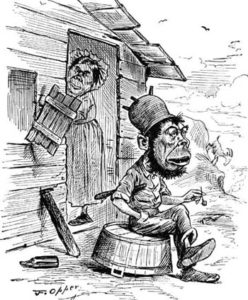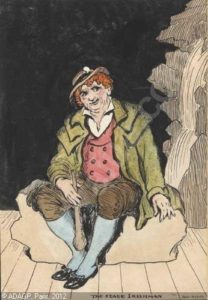

Popular Irish melodramas from the Victorian and Edwardian periods were formulaic. One-dimensional characters populate a picturesque emerald landscape dotted with ruins and sheep, a landscape deeply engrained in the Irish collective consciousness. A noble yet forgettable hero falls in love with a devoted, self-sacrificing beauty while he struggles against greedy landlords or lawyers, agents of colonial rule. And at his side stands a stereotyped stage Irishman. Redefining and repeating both the stage Irishman and his antithesis, the greedy landlord, represented the construction of a “normative self-image” of the Irish people that “[engendered] a clear system of values…which structure the cultural supply of knowledge and the symbols.”[1]
A boisterous buffoon prone to drink and violence, the stage Irishman fulfilled many of Victorian England’s social Darwinist prejudices against the Irish as a whole.[2] First appearing in anti-Irish accounts of the Famine, this depiction allowed the British to “paper over [their] complicity in the disaster,” helping to “rationalize England’s continued hegemony over its colonial possession.”[3] They filled a role similar to the stock ‘sambo’ character in American theater of the time. Whitbread’s Lord Edward even pairs the stage Irishman Thady with a stereotyped African-American Tony.[4] Nationalistic melodramas from the late nineteenth century, however, elevated this comic character into a national symbol. Drunk and uncouth he remained. But he was also clever, self-reliant, loyal, and above all patriotic. Whitbread’s “representations of ‘native’ Irishness and Englishness consistently countered the invidious characterizations of Irishmen promulgated by a number of Victorian texts, theatrical or otherwise.”[5] Shane McMahon inWhitbread’s Wolfe Tone, for instance, reverses the emasculation of Irish characters when he confronts the weak, ugly Joey Rafferty. The stage Irishman’s cleverness is often revealed in the ability to detect aristocratic plots against his master or friends. Thady, for instance, recognizes Magan’s treachery against Lord Edward Fitzgerald before anyone else. Lord Edward’s young son also innately distrusts Magan, suggesting a natural purity. Stage Irish also embody a spirit of the nation which cuts across class lines. Mykes-na-Coppaleen from Boucicault’s The Colleen Bawn helps the deracinated Eily assume her true Irishness through the brogue, a move approved by the refined Anne Chute.[6] Thady from Lord Edward identifies Kitty as a Wicklow girl even as she masquerades behind a French accent. Most importantly, a leveling of social class occurs by his inclusion on the stage with the patriotic hero: “melodrama depicted the nationalist project as one that united social classes, one that in fact required the cooperation of brave peasants and Anglo-Irish gentry alike.”[7] Patriotism alone can unite the nation.
Stereotyping the villains also helped the audience identify with greater sources of English oppression. Earlier works by Boucicault tended to depict the villain as a ‘rogue colonialist’ who acted according to their own selfish interests rather than representing a system of oppression. Watt, however, suggests that when dramatic portrayals are put in their cultural contexts, these figures can be seen as representing a system of oppression. Melodrama locates the source of conflict outside the individual, unlike tragedy. Focusing on an external villain rather than a hero’s internal conflict, which is characteristic of melodrama, plays on “‘man’s impulse to think well of himself’ [rendering] him ‘susceptible’ to act as a ‘partisan against oppressive men or defective principles.’”[8]
Identity
Identity and the Literary Revival
Identity and Musicals
Political Melodramas
Memory and Political Melodramas
Reception and Political Melodramas
Hamilton and Cathleen Ni Houlihan?: Irish and American Dramatic Representations of Colonial Rebellion
[1] Jan Assmann and John Czaplicka, “Collective Memory and Cultural Identity,” New German Critique, no. 65 (1995), 131.
[2] Edward Hirsch, “The Imaginary Irish Peasant,” PMLA 106, no. 5 (Oct. 1991), 1119.
[3] Stephen Watt, “Late nineteenth-century Irish Theatre: before the Abbey – and beyond,” in The Cambridge Companion to Twentieth-Century Irish Drama, ed. Shaun Richards (New York: Cambridge University Press, 2004), 23-24.
[4] Cheryl Herr, For the Land They Loved (Syracuse: Syracuse University Press, 1991), 109.
[5] Stephen Watt, Joyce, O’Casey, and the Irish Popular Theater (Syracuse: Syracuse University Press, 1991), 63.
[6] Watt, Joyce, O’Casey, and the Irish Popular Theater, 65.
[7] Watt, “Late nineteenth-century Irish Theatre”, 28.
[8] Watt, Joyce, O’Casey, and the Irish Popular Theater, 63.


